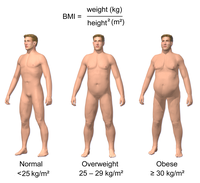Classification of obesity

Okay kiddo, so you know how everyone's bodies are different and come in different shapes and sizes? Well, sometimes people's bodies can be considered overweight or obese if they have too much extra weight on them.
Now, doctors and scientists have come up with different ways to classify obesity. They use something called BMI, which stands for Body Mass Index. Basically, it's a fancy way of measuring someone's body fat based on their height and weight.
If someone's BMI is between 18.5 and 24.9, that means their weight is considered normal. If someone's BMI is between 25 and 29.9, they are considered overweight. And if their BMI is 30 or higher, they are classified as obese.
Now, within the category of obesity, there are different levels of severity. Someone with a BMI between 30 and 34.9 is classified as Class 1 obesity, someone with a BMI between 35 and 39.9 is Class 2 obesity, and someone with a BMI of 40 or higher is considered Class 3 obesity, which is also known as morbid obesity.
It's important to keep in mind that BMI is just one way to measure obesity, and it doesn't take into account things like muscle mass, bone structure, or overall health. So it's always best to talk to a doctor about any concerns you might have about your weight or health.
Now, doctors and scientists have come up with different ways to classify obesity. They use something called BMI, which stands for Body Mass Index. Basically, it's a fancy way of measuring someone's body fat based on their height and weight.
If someone's BMI is between 18.5 and 24.9, that means their weight is considered normal. If someone's BMI is between 25 and 29.9, they are considered overweight. And if their BMI is 30 or higher, they are classified as obese.
Now, within the category of obesity, there are different levels of severity. Someone with a BMI between 30 and 34.9 is classified as Class 1 obesity, someone with a BMI between 35 and 39.9 is Class 2 obesity, and someone with a BMI of 40 or higher is considered Class 3 obesity, which is also known as morbid obesity.
It's important to keep in mind that BMI is just one way to measure obesity, and it doesn't take into account things like muscle mass, bone structure, or overall health. So it's always best to talk to a doctor about any concerns you might have about your weight or health.
Related topics others have asked about:
